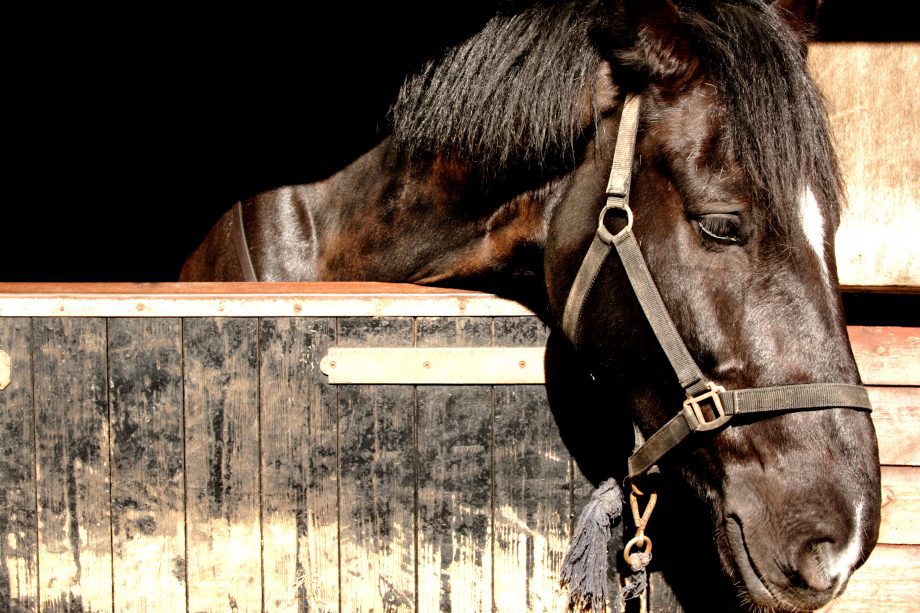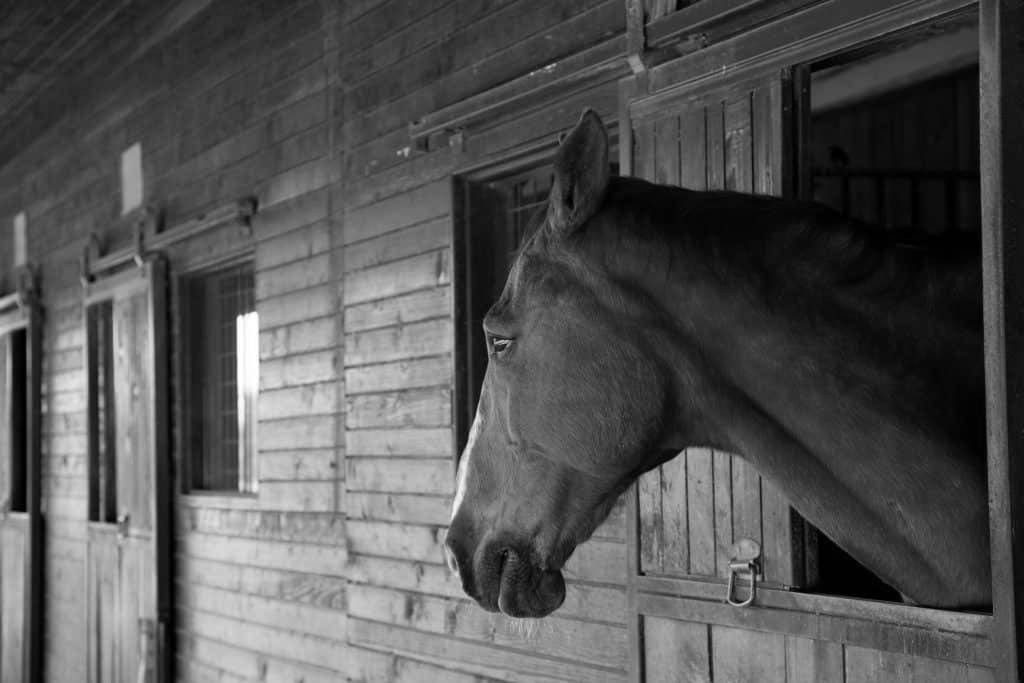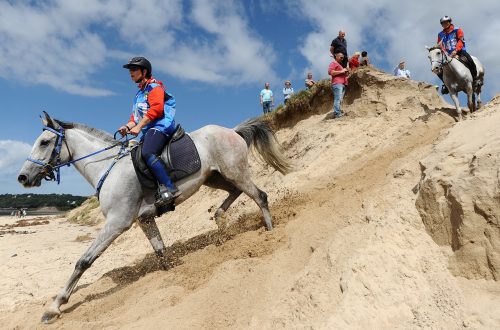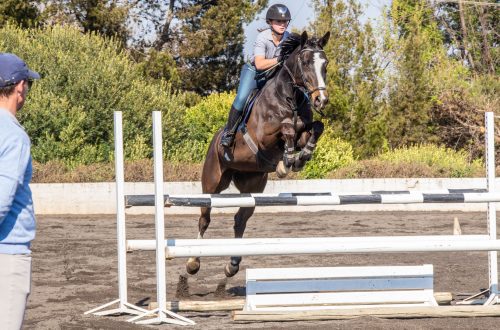
If your horse is “depressed”…

Photo taken from ihearthorses.com
We all know that sometimes people experience depression and can become depressed. But what about horses?
It turns out that horses can also feel similar experiences. How to recognize that your horse is unhappy and what to do to bring joy back into his life? How can I make her enjoy her work?
Recognizing Depression in Horses
A depressed state in a horse can be expressed in different ways. As a rule, it can be detected even without working on horseback.
Three main criteria by which to determine «horse depression» is:
1. Posture
According to a scientific study, depressed horses exhibit an unusual, uncharacteristic, “closed” posture. Such a horse will stand perfectly still, with its eyes open and its neck extended in line with its back. The gaze is absent-mindedly looking forward, the ears do not move, reacting to sounds – no interest in the world around.
At the same time, horses that are in a depressed state react more sharply to loud sounds and sudden, sharp movements, while remaining indifferent to all events around, whether it is a saddle, cleaning, or the appearance of a groom distributing hay.
2. Behavioral changes
An unhappy horse becomes irritable and nervous. This can be determined by her behavior during cleaning, saddle and other procedures.
The horse may not show interest in food and grazing, avoid communication with comrades in the stall and levada. An indicator will be the fact that the animal stands motionless for hours in the same position.
3. Problems while riding
Suppressed horses are reluctant to follow commands while working under the saddle, refuse to move forward from the leg, and are inattentive to the actions of the rider.
When the athlete tries to achieve the element and resorts to the help of additional means (spurs or whip), the horse presses his ears, beats and tails, resisting the commands. In some cases, a dressage horse may refuse to enter the fighting field, starting to “glow” and “short” before entering.
Having dealt with the main signs of equine depression, one should ask the question: what exactly makes a dressage horse unhappy?
There are many reasons for this, but the main ones are:
1. Pain or discomfort
Pain and discomfort are the most common causes of horse stress, regardless of the discipline in which it competes.
Painful injuries do not allow the horse to rest in the stall, further aggravating his condition. During work, the horse cannot concentrate and perform the element correctly due to constant discomfort. This can lead to new injuries and only worsen the situation.
2. Social isolation
Some horses are kept in isolated stalls or left alone for a long period of time while their companions walk in the paddock. Such social isolation and lack of communication with other horses can be a major cause of depression, stress and depression in the animal.
3. Lack of walking
By nature, horses are forced to move frequently in search of pasture and water. Even when domesticated, the horse has retained this instinct to be constantly on the move. Therefore, if your four-legged partner is most of the time in a closed space, without the opportunity to “unwind” in levada, then soon he will develop stall defects and lose any interest in what is happening.
4. Wrong work
Dressage is a challenging discipline for horses and riders alike. Often trying to get the best performance of an element, we continue to repeat it over and over again, not feeling the fine line when to stop.
Overwork during work can lead not only to physical fatigue of the horse, but also to moral exhaustion. Constant exhausting work causes stress and dislike of the horse to riding.
And harsh training methods or coercion, systematic misuse of aids, lead the horse to associate work under the mount with discomfort. It is not difficult to guess that after this, her desire to cooperate with the rider will come to a minimum.
5. Monotony in work
And again about the correct work under the top – do not get hung up on one element or bunch. Endless repetition of circles or side exercises with occasional changes of direction is a sure way to tire your horse. Add new exercises to the work process, change the environment and the duration of training. Horses are intelligent animals and they just need variety in their work!
6. Transportation
It is difficult to enjoy transportation in a trailer or a large horse carrier. Confined spaces, cramped spaces, poor ventilation all cause stress and a feeling of claustrophobia in the horse.
Transporting a horse, especially over long distances, can cause a depressed mood. Therefore, try to ensure maximum comfort for your partner during transportation and let him rest upon arrival at the place.
7. Own nervousness
If you are stressed in competition, then know that your horse feels it too. Horses quickly catch changes in the emotional state of their riders. Therefore, your anxiety and anxiety will be transferred to the horse.
Now that we have covered the main sources and causes of stress and the depressive state of the horse, let’s move on to problem solving.
The first thing to do is to make sure that the horse is not bothered or hurt by the injuries. Consult your veterinarian and make sure, that Definitely not a health issue. And only after that you can try other options that will help diversify the life of the horse, make it happier and more interesting.
1. Find a companion
If your horse is dejectedly standing alone in the stall for most of the day, then find a friend for it – perhaps this will be the solution to all problems. Put another horse in a nearby stall or find a “walking mate” with whom she will spend time in the levada. If this is not possible, then consider adding a “neighbor” to the stall – a goat, a sheep or a donkey.
2. Get rid of the aggressor
Sometimes a horse that is constantly being attacked aggressively by other horses may show a depressed state. Take a closer look at how your horse interacts with others. If he really suffers from the excessively aggressive behavior of other animals, then protect him from the aggressor. Change the walking time, the stall, or hang a special curtain on the bars.
3. Increase the amount of time spent outdoors
If the horse spends most of his time in the stable, make sure that he spends at least a couple of hours in an open stall outside, in a paddock or pasture.
The ability to move freely is important for the emotional state of the horse. Just a couple of hours on the street will help cheer up your friend and cheer him up.
4. Proper feeding
Whether your horse is standing outdoors or in a covered stall, he should always have access to enough food.
The digestive system of horses is designed in such a way that it needs constant “pushing” of roughage in order to function properly. If a horse is on a diet that is deficient in fiber and roughage, it can develop stomach ulcers. This leads to discomfort, pain and depression.
Therefore, it is important to ensure that the horse has access to grass, hay or haylage throughout the day.
5. The right equipment
If the saddle or bridle does not fit the horse, then he will experience discomfort every time you use the wrong piece of equipment during training.
Unfortunately, horses cannot tell us that the noseband is too tight, the snaffle is too small, and the saddle is pressing on the shoulders. Therefore, the task of the rider is to ensure that the ammunition is correctly selected, in no case rubs and does not cause discomfort to the horse.
6. Add variety to your workouts
Daily repetition of the same elements, riding in the arena and endless rolling of schemes can discourage not only the rider, but also the horse.
A tired horse that has lost interest in training will never be able to fulfill its potential, and a sluggish or overly intense performance will clearly not deserve good marks from the judges.
To avoid boring workouts and loss of interest in dressage, try to diversify your training schedule.
Think:
- Are you usually asking too much of a horse in one session?
- Are your teaching methods too harsh?
- Are you giving your horse enough time to rest?
- Are your exercises varied enough?
And if after these questions you realize that you need to change something, then add the following exercises to your work week:
- Work on a long rein for relaxation;
- Riding on rough terrain;
- Work on poles;
- Jumping training (no need to jump the height of the Grand Prix, small hurdles are enough!)
- Cord work.
Every horse is different and you may need to experiment. Try everything suggested above to find the perfect balance. But trust me, it’s worth it.
And remember: in order for a dressage horse to reach its full potential and willingly cooperate with a rider, it must be happy. After all, one of the main principles in dressage is «happy horse» (happy horse).





